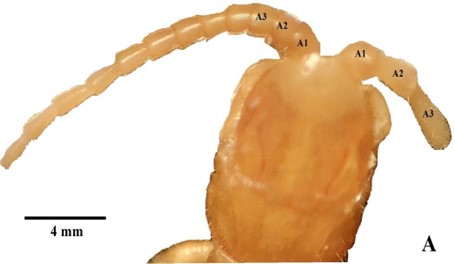Introduction
The oldest published records of abnormal phenotypes in centipedes date from the late 19th and early 20th centuries with studies by Hutton (1878), Brölemann (1894, 1904), Duffaut (1908) , Selbie (1913) , and Takesita (1918) . Balazuc and Schubart (1962) were the first authors to review and classify all previous published records of abnormal phenotypes in centipedes.
Morphological anomalies in chilopods are scarce and very rare (Leśniewska 2004), thus being a little-known line of research. After Balazuc and Schubart (1962) , one of the recent classification and additional contributions was made by Minelli and Pasqual (1986) who described various malformations in chilopods. On a more contemporary timeline, Leśniewska (2004) and Leśniewska et al. (2009) documented various malformations in geophilomorphs, Stojanović et al. (2019) present the bifurcation of an ultimate leg in Cryptops parisi Broleman, 1920; Tuf and Dányi (2017) present abnormality in the coxal pores in Lithobiomorpha and Cabanillas (2021) who, after the analysis of Spanish specimens, reported several teratologies.
The same authors noted the low frequency of malformations in chilopods. Mitić and Makarov (2007) reported that only 0.71% of the total number of specimens had anomalies. On the other hand, Vega-Román and Ruiz (2015) collected a total of 500 specimens throughout over 5 years and only found three specimens exhibiting morphological anomalies (0.006%).
In Chile, studies on malformations in chilopods have been scarce. Vega-Román and Ruiz (2015) were pioneers in describing morphological anomalies in these arthropods, reported three cases: an atrophy in the locomotor appendages and two schistomelia, which remain the only teratologies documented to date in the country.
The present study provides the first contribution of a teratology in scolopendromorphs of the genus Cryptops in Chile by describing an abnormal antenna.
Materials and methods
A total of 30 centipede specimens were collected in the central-southern area of Chile using pitfall traps in a campaign carried out between 2017 and 2019.
Specimens were identified using a stereomicroscope (Olympus SZ40) based on the diagnostic characters of Lewis (2011, 2013) and Mundel (1990). Images were taken using a digital camera (Nikon D3000). The terminology proposed by Bonato et al. (2010) was used for the standardization of names and abbreviations. Finally, Balazuc and Schubart (1962) were considered when naming the teratology.
Results and discussion
Case: Cryptops Leach, 1815, 1 specimen, Chile, Concepción, Penco. Cerro La Huasca, Lirquén (36°42′24″S; 72°58′18″W), pitfall trap. February 2017, coll. Vega-Román, E.
Atrophy. Different sized antennae. The right antenna is shorter, and it only has three antennomeres, which are distinctly larger (particularly the antennomere 3) (Figure 1).

Figure 1 Morphological anomaly in Cryptops Leach, 1815. Dorsal view. Right antenna is shorter and has 3 antennomeres.
The morphological complexity of this possible anomaly brings us to believe that it is not the result of a regeneration, despite the complexity in determining whether a teratology is due to abnormal development or a regenerative process (Mitić et al. 2011). We base this assumption on a similar teratology described by García-Ruiz (1995) in a specimen of Scolopendra cingulata Latreille, 1829, where the author presumed its origin as a developmental anomaly (Fig. 1).
In a review of morphological abnormalities in chilopods, Stojanović et al. (2019) documented 23 studies on chilopod schistomelia, only one belonging to the genus Cryptops. The mentioned work was the first to document this type of malformation in Cryptops.
Contrary to what was observed in this case, Fründ (1992) states that the regeneration and/or healing processes are identifiable by means of dark spots on the specimens. There is apparently no visible sign that this specimen has been damaged and subsequently regenerated. Other body segments are symmetrical and do not show differences (locomotor appendages, anal appendages, coxal pores, etc). Based on this, the reappearance of appendages through a regeneration process cannot be directly cited as the cause of this possible anomaly.
Arthropods do not regenerate any missing part of the body. However, it is possible to have regenerative capacity, product of ecdysis, which can be carried out throughout life (Minelli, 2003). A general agreement is that appendage regeneration is widespread in myriapods (Minelli et al. 2000; Maruzzo et al. 2005).
The regeneration process in chilopods has been previously documented (Mitić et al., 2010). However, in antennae appendages it has been scarce. Lewis (1968) pointed out a smaller number of antennal segments specifying them as a regenerative process. However, he also pointed out that it is necessary to continue with studies that allow us to reliably corroborate the symphysomely.
If this specimen is recognized as presenting an abnormal developmental process, we believe its origin could be due to the specimens being collected in areas close to communities with high anthropic and industrial development, which could explain these anomalies. This situation is not merely anecdotal: Vega-Román and Ruiz (2015) also documented specimens with this type of condition in nearby towns.
Along these same lines, García-Ruiz (2003) carried out a study analyzing the effects of debris deposits on chilopod populations, demonstrating that the changes produced in the soil by the deposition of inert urban solid waste (debris) produce negative and enduring effects in chilopod communities.















